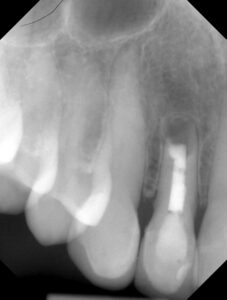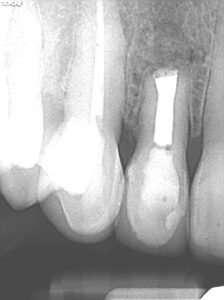
What Is an Apicoectomy?
In endodontics, an apicoectomy is a specific type of surgery that pinpoints infections around a tooth’s root and surrounding tissue. Often referred to as the apex, this is where the tooth’s nerves and blood vessels meet and join the rest of the mouth. Even after a thorough root canal, this procedure can remove any extra infected tissues in the surrounding bone area and save the tooth from further infection.
When would an Apicoectomy be recommended?
When root canals can’t solve the issue, an apicoectomy is necessary to ensure that all the infected areas in the bone, around the apex or tip of the root, have been cleaned, removed and sealed. . Your dentist or endodontist will recommend an apicoectomy when:
- Ongoing infection: even after your root canal procedure, if pain persists, it can be caused by root tip bacteria, which may not have been completely removed in the initial root canal treatment. Sometimes these bacteria are impossible to remove through a traditional root canal since they may reside on the outer surfaces of the root.
- Deep root anatomy: some mouths have complex or unusual anatomy, making it difficult sometimes to clean out during the original procedure
- Anomalous anatomy: Such as when the root tip of upper teeth naturally fenestrate through the buccal bone, or the roots have a bulbous root end.
- Things in the way: obstructions (from a severely calcified root, rotary or hand file instruments, ledges within the root canal space, posts, or unusually curved anatomy) can sometimes prevent the dentist from being able to clean the entire root canal system fully. The remaining infection at the tip of the root can be removed and sealed with an apicoectomy.
What does the Apicoectomy procedure look like?
Your endodontist, such as Chaim Jakob. DMD, is highly trained in this microsurgical procedure. The endodontist will perform this procedure under local anesthesia to help completely numb the area so that you don’t feel any pain during this procedure.. The steps for the procedure are as follows:
- Numbing the area with anesthesia: to start the process, the endodontist will numb the area around the infected tooth to make sure you stay comfortable during the procedure
- Creating access to the root tip: Gum tissue will be reflected to help uncover the root tip and infected areas of bone at the apex.
- Treated the infected area: the endodontist will use specialized tools to locate and remove the infected tissue at the tip of the root. The bone where the cyst or granulation tissue resides is removed during this step.
- Sealing the root: a bioceramic putty or MTA cement filling material is placed inside the root canal space to ensure infections don’t further impact the affected area.
- Closing the area: A bone graft and a biological membrane is placed inside the crypt to help fill the space in the bone and allow for your body to remineralize and heal the defect in the bone. the cleaned-up and reflected gum tissue is then sutured together and left to heal.
What does the recovery look like?
More often than not, most patients of an apicoectomy will be back on their feet right away. This can commonly be accompanied by a bit of tenderness and discomfort that can be alleviated by over-the-counter pain medication. There can also be slight swelling in the area, so we recommend ice packs or ice to help keep the swelling down.
The endodontist will have a list of guidelines to follow once the procedure is completed and that might include:
- Avoiding hard or crunchy foods for a few days
- Rinse the infected area with salt water or an antibacterial rinsing solution such as peridex to help keep the area.
- Ensure you schedule a 5-7 day follow up to help monitor the healing process and to remove any remaining stitches.

What are the advantages of an apicoectomy?
As with the original root canal procedure, the objective is to save your natural tooth. Due to some of the anomalies listed above, this extra procedure will help eliminate infections and ensure the long-term health of your teeth and supporting bone. Other options down the line include extraction and tooth replacement. Your local endodontist will always give you the best options for your long-term oral health and try their best to keep your natural tooth.
Apicoectomy Frequently Asked Questions
- Is an apicoectomy painful?
During the procedure, a local anesthetic will be applied, and shouldn’t be too painful. Post-surgery, it is normal to have some slight discomfort. Most patients feel great within 24-48 hrs. Treat accordingly with antibiotics and pain medication - How long is the procedure?
At Jakob Endodontics an apicoectomy will take anywhere between 30-60 minutes depending on complexities in each case.
How will my tooth function after the procedure?
The main objective of an apicoectomy is to ensure the lifespan of your natural tooth and avoid extractions. Once the procedure is completed, your teeth should function fully.
